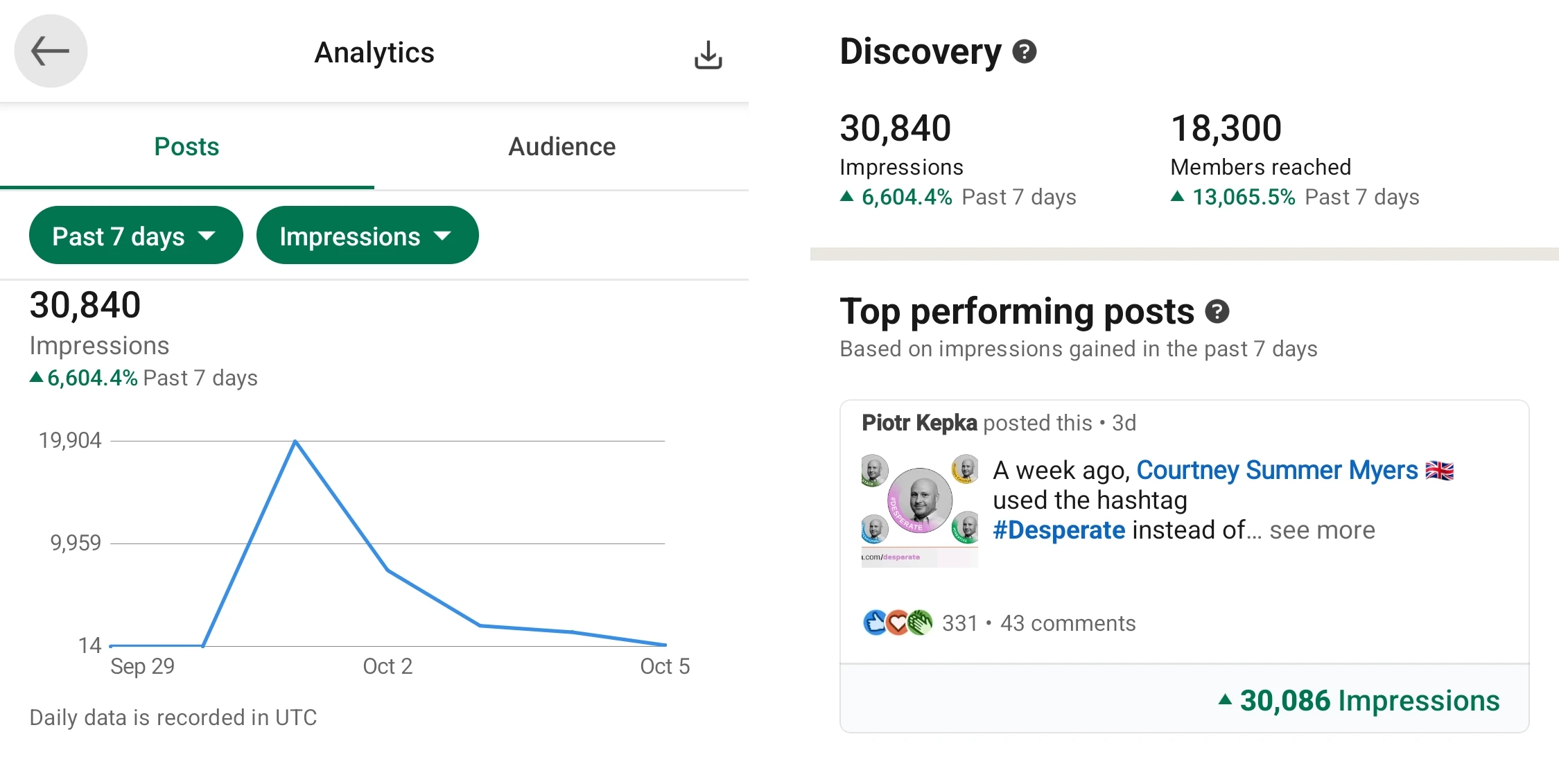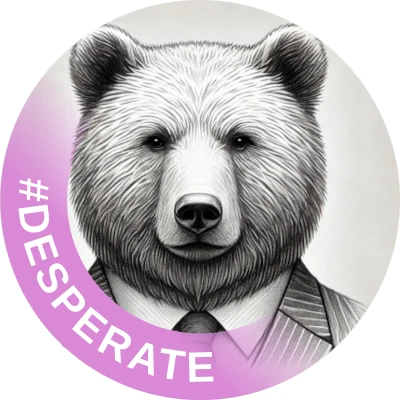Category: Local-First Software
How I Accidentally Went Viral on LinkedIn with the #Desperate Hashtag. And a Bear

Piotr
Oct 9, 2024
Picture this: you’re sitting at your computer, working late into the night on a quirky project you started on a whim. You finally wrap it up and, instead of posting immediately, you decide to sleep on it. Early the next morning, you hit "post" on LinkedIn and go about your day. By the time you check back, you’re semi-viral. That’s exactly what happened to me, turning the hashtag #desperate into a platform for creativity—and a surprising moment of social media fame.
The Desperate Badge and the Birth of My App
It all started with a LinkedIn post by Courtney Summer Myers 🇬🇧, where she introduced the #desperate badge as a cheeky overlay for job-seekers to show their determination. Like many, I’m currently navigating a tough job market. But rather than just using the badge, I had an idea: Why not create a tool that allows anyone to design their own custom banner?
So, late one afternoon, I took to coding. By 3 a.m., after combining my front-end skills with some basic graphic design, I had a working app that could apply personalized banners to LinkedIn profile pictures. And because Bern, Switzerland—where I live—was named after a bear, I threw in an Easter egg: a bear. To try the app, users could slap the #desperate banner (or any custom text) onto a bear picture, without needing to share any personal data. The app was designed to be secure and operate entirely within the user's browser. Otherwise, who would trust a random guy on the Internet with their picture?
But here's where things took a wild turn.
From Idea to 30,000+ Impressions in Days
I posted about my new tool on LinkedIn, fully expecting maybe a handful of views from friends. The next morning, I had almost 20,000 impressions, over 150 reactions, and nearly 20 comments. My phone wouldn’t stop buzzing. On October 1st, the post reached its peak, with thousands of people engaging. By October 5th, the post's virality slowed, but it had already hit over 30,000 impressions and 330 reactions in total.
Why Did It Go Viral?
The secret sauce? Timing. I launched my app right as the #desperate badge was gaining momentum on LinkedIn. The badge struck a chord with people worldwide, frustrated with their job search struggles. My app, which allowed users to easily create custom banners, offered a quick, fun way to join the trend—no graphic design skills needed, and it could all be done in under a minute.
What made it stand out even more was how simple and secure the app was. Users didn’t have to upload any personal data, everything worked directly in their browser. No graphic design skills were required. It was just me, my app, and a quirky bear.
What Came Next?
Besides a flood of LinkedIn notifications, I received about 40 networking opportunities. Some people offered to recommend me for jobs, and while I didn’t land any concrete offers from the viral post (yet), I’ve certainly expanded my network in ways I never expected. And let’s face it, in today’s job market, visibility is currency.
Reflections on Going Viral
Going viral is a strange, exhilarating, and overwhelming experience, especially for someone who had rarely posted on social media before this. In just a few days, I saw firsthand how quickly something can snowball online. What started as a fun side project transformed into a viral moment—and a personal lesson in seizing opportunities.
So what’s next? Well, I’m continuing to explore projects like this, sharpening my skills, and trying to stand out in a very competitive market. If nothing else, this experience has reinforced one thing: don’t wait for the perfect opportunity to showcase your skills. Sometimes, you just have to throw a bear into the mix and see what happens.
And if you want to check out my app or learn more about my projects, head over to piotrkepka.com/desperate.
Now, let’s see what I can cook up next. Hopefully, it doesn’t involve staying up until 3 a.m. again... but no promises.
Statistics
I believe in being transparent because it helps build trust and fosters stronger relationships.

My Thoughts on Local-First Software

Piotr
Sep 14, 2024
As a full-stack engineer with a strong background in cybersecurity, including certifications like CySA+ and Security+ from CompTIA, I’ve come to believe that local-first applications are the future of secure and reliable software. While not all of my apps currently follow this model, it’s something I’m increasingly focused on for the privacy, control, and resilience it offers.
As a full-stack engineer, I've always kept in mind the importance of building applications that offer users privacy, security, and control over their data. With my experience in software development and cybersecurity, I’ve gradually come to believe that local-first applications are a strong way to achieve these goals.
Local-first applications are built to store and process data primarily on the user’s device, rather than relying heavily on cloud servers. From a security standpoint, this offers some clear advantages. Storing data locally means it’s less exposed to potential breaches that could occur in the cloud. Users aren't constantly transmitting sensitive information to external servers, which reduces the risk of hackers intercepting or exploiting that data.
This ties directly into the privacy benefits of local-first apps. Because data is kept on the user’s device, they have far more control over who accesses it and when it’s shared. It’s a model that empowers the user, giving them the final say on when and how their data gets uploaded to the cloud. As someone with a cybersecurity background, including certifications like CySA+, I’ve seen how essential it is to minimize the points where data can be compromised. Local-first applications inherently do this by reducing cloud dependency.
There’s also the added advantage of offline functionality. Local-first apps don’t rely on an internet connection to work properly, which is a huge benefit, both from a user experience perspective and for reliability. Whether you're working in a remote location, traveling, or simply dealing with unstable Wi-Fi, local-first applications allow you to continue using them without interruption. This makes them not only more convenient but also more resilient than cloud-first alternatives.
While not all of my current applications are built with a local-first approach, it’s something I’m focusing on more. The principles of privacy, security, and user control are increasingly becoming central to how I approach new projects. Local-first architecture will play a big role in the apps I develop going forward because it aligns with the kind of reliable and secure software I believe people need today.
As I continue exploring this model, I’m confident that local-first applications are the future for those who want greater control over their data and peace of mind when it comes to privacy and security.
